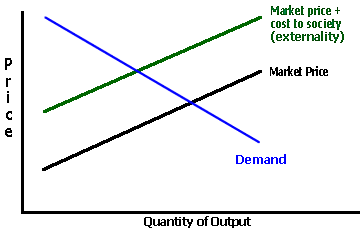 Policy Options: Subsidies
|
||||||||||
Two scenarios can be demonstrated with this graph. First, we can see how, without accounting for negative externalities (i.e. pollution), prices will be artificially low. With the same demand curve, the market will set the supply at the market price. As you can see, where the demand curve intersects with the market price, this results in inefficiency- too much output at a reduced price. Governments benefit society when they set policy to include externality costs into the market price. Also, we can demonstrate how a subsidy works. Subsidizing a fuel artificially lowers the price curve to the lower position (market price graph). Since we spend $150 billion on conventional fuel subsidies, and also don't include the externalities in price to the consumer or industry, fossil fuels are cheaper. Minimizing these subsidies and/or creating temporary subsidies for renewables will help make the relative prices for all fuels more realistic. |
Subsidy reform: Replace old subsidies
with temporary ones that promote clean energy use
International Energy Agency/United NationsA 'good subsidy' is one that enhances access to modern energy or has a positive impact on the environment, while sustaining incentives for efficient delivery and consumption |
We must be careful when creating any type of subsidy. However, temporary subsidies for renewable energy can be beneficial, if a few criteria are followed. These subsidies can promote the needed competition for clean energy technologies and boost their capacity (leading to natural price reductions). Fossil fuels currently monopolize the market because of government assistance- it is only fair to give all fuels an equal chance to be competitive. Subsidizing renewables helps boost energy access to rural developing communities and lowers prices for renewables in industrialized nations to make them more cost-competitive. These subsidies can be justified because they lead to better health worldwide, to enhanced energy security and to sustainable development goals.
Types of energy subsidies
> Table 2
(click to expand table) | Example |
|
|||
| lowers cost of production | raises cost of production | lowers price to consumers | ||
Necessary components of subsidy legislation
- Sunset clause!! We must not become dependent on subsidies. The policy should have a reasonable schedule to gradually lessen the subsidy
- Transparency: The public must be able to find out how much the government spent on the subsidy and which people and/or groups received subsidy money
- Well-targeted: It must be directed to people who are meant and deserve to benefit from them. Too often a subsidy benefits energy companies and the wealthy disproportionately (i.e. LPG subsidies in India), so consider more local targeted projects
- Efficiency: Subsidies should boost, not undermine a supplier's incentive to provide or a consumer's ability to use the energy supply
- Cost effective: Perform a cost-benefit analysis
- Practical: The subsidy must be affordable and reasonable to administer
Case Studies
China's policy to reduce coal subsidies
Nepal's Biogas Support Programme
Denmark's wind subsidies
Resources:
Reforming Energy Subsidies, The impact of energy subsidies on sustainability, UNEP/IEA Workshops
Energy for Sustainable Development, A Policy Agenda, UNDP
